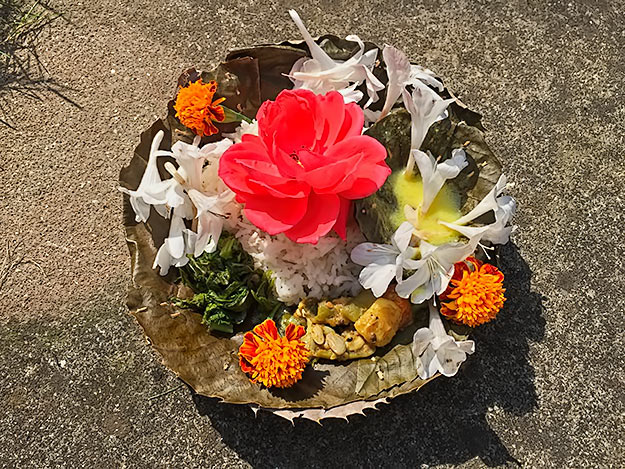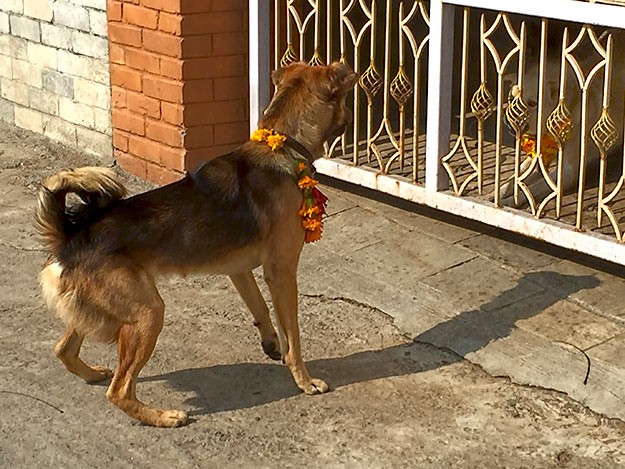Five years ago my Yoga guru invited me to celebrate the Brother-Sister Tika Ceremony with his family during the Hindu holiday of Tihar in Nepal. Though I didn’t know it until the end of that day, accepting his invitation meant that I was officially “adopted” by the family. In many ways, this cemented my relationship with Nepal; I loved it before, but after experiencing Tika in Nepal I was absolutely addicted. Since that day, I have visited many times, but my schedule had never put me there during Tihar, so it was with great excitement that I arrived in Pokhara this past November to celebrate the full five-day holiday with my family.
Stories differ about the origin of Tihar, which is also known as the Festival of Lights. One of the best known is an ancient Hindu legend about a king whose astrologer told him a serpent would take his life. When the king asked if there was any way to escape death, the astrologer advised him to sleep with oil lamps lit around his bed and to decorate the palace with oil lamps on the day when the goddess Lakshmi was to be worshiped. In return for being so honored, Lakshmi persuaded the serpent to spare the king’s life but Yama Raj, the god of the underworld, still had to be convinced that it was not yet the king’s time to die. Yama opened his ledger to where the king’s remaining age was written as zero but the serpent cleverly put a seven before the zero and the king lived for seventy more years.

Day one of Tihar in Nepal is dedicated to the crow, which is the messenger of Yama Raj. Bhai (older brother) set out a plate of food to honor the crow early in the morning on this first day and we all sat on the porch, delightedly watching as crows flew down from the power lines to peck at the food. Dogs, which are believed to guard the gates to the underworld, are honored on day two. Families place a tika (a mark made with colored powder) on the forehead of their dog, hang a garland of flowers around its neck, and feed it a plate of food. Since my family does not own a dog, they set out a heaping plate of food on the street for the ubiquitous strays that roam the town.

Day three, considered to be the most important day of Tihar, is devoted to cows, which are sacred to Hindus. They symbolize wealth and are considered mothers of the universe due to their ability to produce milk. On that morning, Bahini (little sister) and I walked over to the house of a neighbor who keeps a cow. She carried a tray of colored powder, flower petals, marigolds, and some goodies for the cow such as apple slices. The owner tied colored threads on the tail of the cow, while Bahini placed a tika on its forehead and sprinkled it with flower petals. Then she dipped a marigold in a flour and water mixture and dabbed it all over the hide of the cow before feeding it treats.
This ceremony often involves drinking a drop of cow urine or sprinkling it on participants. Sure enough, when the cow let loose with a long, steamy stream of urine, the neighbor gleefully rushed over to capture some of it in his hand and sprinkled it over us. Bahini ended the ceremony by decorating a mound of cow manure with the marigolds. Since cow dung is used to fertilize the fields in Nepal, this ritual is an homage and prayer to the gods to ensure abundant crops. Later that same evening, my family offered similar prayers to Lakshmi, goddess of wealth, to ensure a profitable upcoming year.
That same afternoon, I strolled the main street of Lakeside in Pokhara, enjoying troupes of children who were going from store to store, dancing and singing the special Bhailo song that is performed only during Tihar. After performing, shop owners reward the children with gifts of small amounts of money, candy, candles, and fruit. As darkness fell, those same shop owners set tea candles on their stoops, windowsills, and sidewalks, turning the town into a sea of glittering light – truly a Festival of Lights.
While day four sees offerings made to other bovine animals like oxen and buffalo, it is also a day of preparation for the Brother-Sister Tika ceremony that occurs on day five. On that final day, extended family members began arriving early in the morning to help with preparations. Delicious smells soon suffused the house and I rushed to dress and go downstairs to see what was happening. Bahini’s two sisters were cooking Selroti, large rings of rice flour dough which are fried in hot oil until crispy. My mouth watered, but no one was allowed to eat until after the Brother-Sister Tika ceremony.
At 11:45 a.m., everyone gathered on the front porch, waiting for the clock to strike 11:55, which the national astrologer of Nepal had declared the most auspicious time for the tika ceremony to commence. At the designated time, the oldest son sat cross-legged on the stone floor. His two sisters circled him three times, pouring oil and water on the ground, then knelt and anointed his head with oil. The entire family then gathered around to apply a seven-color rainbow tika on his forehead. The two sisters took their turn next, followed by other members of the family, until everyone had received their rainbow tikas.

Finally, it was time to eat. Bahini and her sisters brought out plate after plate of special holiday fare and we stuffed ourselves until we couldn’t take another bite. It was like Christmas, Thanksgiving, and Halloween, all rolled into one, which explains why of all the holidays I have witnessed in the many countries I have visited, the five-day Hindu celebration of Tihar in Nepal is my absolute favorite.
Considering a future visit to Nepal? You’ll want to check out my Essential Travel Guide for Pokhara, Nepal, which is updated regularly.

What a lovely and informative post. This festival seems a bit like Diwali, and I know there is also a festival in India where everyone ‘pimps up’ his cow…. I like that they also feed the stray dogs.
Hi Bibi: It is actually the exact same festival as Diwali in India – it just goes by a different name in Nepal.